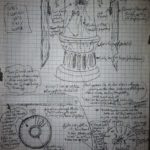Family Across the Stars,
3D-printing has been a technology that has revolutionized many industries, and perhaps even industry itself. In case you don’t know, it is the term for the type of printing that involves not just one layer of ink on paper, but successive layers of many different kinds of materials on a base plate or themselves, creating not a two-dimensional sheet of paper with words or images on it, but three-dimensional objects such as tools, toys, vehicles, and spare parts. With 3D-printing, we can precision-fashion in hours what it would otherwise take traditional craftsmen weeks to assemble. This saves us tons of time, money, and other resources, often reducing costs, schedules, and waste by 80% or more.
The way it works is this: cement or plastic can be fed through a tube the same way ink is through a cartridge to the printer head(s). Once the material is pushed out into the shape of the first layer, the next layer begins, and as previous layers are cooling and hardening, they begin to provide just the right amount of structural support for the newer layers being added to them. Metal powder can also be laser-fused, the loose remainder blown or sifted away to reveal what was created underneath. Sunlight can also be focused onto piles of sand in a similar process, 3D-printing with glass.
Artists began 3D-printing figurines of people, such as action heroes from comic books, several years ago. Automotive engineers and manufacturers began 3D-printing working vehicles, driving them, fully functional upon the completion of the printing, right out of their large 3D-printer chambers. Dentists and doctors began 3D-printing teeth, skull replacements, ears for burned firefighters, and even entire organs. Even chefs are using 3D-printers; they make thousands of hors d’oeuvres and tiny sample desserts within minutes, and ice entire cakes flawlessly within seconds. The most affluent of them even have kitchens with robotic arms for this hanging overhead, no longer just racks of hooks holding pots, pans, and utensils.
Our logical next step, which evolved the technology of 3D-printing into a whole new generation, was to 3D-print in both living and synthetic tissue. This allowed us not only to clone lifeforms, but to create them fully-matured from their first days, rather than having to wait on gestation in real (surrogate) or artificial wombs; cloning vats were no longer necessary, our cloning facility becoming more like a giant 3D-printer chamber instead. Like the vehicle 3D-printers, ours produce complete working models (in both senses of the term) which walk right out, ready for full use.
As of my birth-month this year, we successfully 3D-printed the first of these; the very first Inisfreean from its ‘form-sake’; we printed the perfected physical body of an ICV based on her physical/physique inspiration, the singer from Lebanon named Haifa Wehbe. This first Inisfreean is called Nyria Serra. You will likely see her around town, especially if you plan on meeting me; she is my new method of interfacing with our city’s main computer, her creation having rendered obsolete the keyboard, mouse, and even touch-screen.
Team, this is huge for WGI, as it means we can mass-produce all the personnel and other things we will ever need, keeping our budget in the black and highly flexible for work far above and beyond even here. It also means skyrocketing morale, our computer hardware now as sexy as can be, just like Steve Jobs of Apple Inc. so wisely pushed for with his own computing products. ICVs are designed to be the most beautiful, focused, professional, and satisfying secretaries, assistants, calculators, and versatile all-around workers you could ever hope for. We’ll printing ones just for you in the weeks and months ahead, so you can kiss your old-fashioned desktop or laptop goodbye, and kiss your ICV(s) hello.
To paradise and beyond,
A °
–


